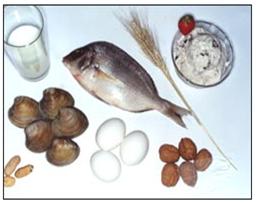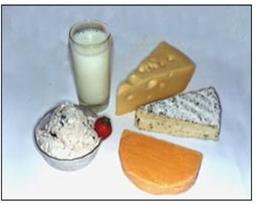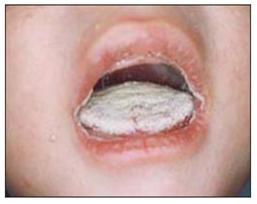모유수유 거절 Breastfeeding refusal
- 때로는 젖을 먹고 울거나 젖을 빨아먹지 않으려는 아기들도 있다.
- 젖을 먹다가 울고 보채고 젖을 먹지 않고 떼쓰는 아기들도 있다.
- 수유모가 먹은 음식물의 성분이 젖과 같이 분비되어 젖 먹는 아기에게 알레르기가 생길 수 있다. 그로 인해 아기가 젖을 먹는 것을 거절할 수 있다.
- 젖 먹는 아기에게 모유로 알레르기가 생기면 아기는 잘 울고 보채고 때로는 아기에게 영아산통이 생길 수 있다.
- 녹변을 보기도 한다.
- 배에 가스가 많이 차기도 하고 배가 탱탱해지고 항문주위가 붉어 질 수 있고 코가 자주 막힐 수 있다.
- 수유모가 알레르기를 잘 일으킬 수 있는 음식물을 계속 섭취하는 한 이런 증상 징후가 아기에게 계속 되기도 한다.
- 또 날이 갈수록 증상 징후가 더 심해질 수 있다.
- 때로는 아기가 젖을 빨아 먹는 것을 완전히 거절할 수 있다.
- 이럴 경우 모유를 짜서 젖병으로 먹이면 아기가 젖병 속에 있는 젖을 더 잘 먹을 수 있다.
- 그 이유는 확실히 모른다.
- 어떤 아기의 입안에 진균이 감염되어 아기의 입에 아구창이 생길 수 있다.
- 드물게는 아구창으로 보채고 때로는 젖을 잘 먹지 않을 수 있다.
- 아기에게 아구창이 있을 때는 입안 점막에 하얀 우유찌꺼기가 묻은 것과 같이 입안 점막층이 하얗게 보이고 아기에게 곰팡이 기저귀 피부염이 동시 생길 수 있다.
- 때로는 엄마의 젖꼭지에도 곰팡이 감염이 생겨 젖꼭지가 가렵고 아플 수 있다.
- 아기가 젖 먹기를 거절하면 부모가 입안을 들여다보고 입안에 어떤 이상이 있나 알아본다.
- 입안에 이상이 있으면 의사의 검진 치료를 받는다.
- 너무 맵거나 특이한 냄새가 나거나 자극성 음식물을 먹은 수유모의 젖에 그런 종류의 음식물의 성분도 나올 수 있다.
- 그런 젖에서 나는 냄새나 이상한 젖 맛 때문에 아기가 젖을 빨아 먹기를 거절할 수 있다.
- 수유모가 자신의 모유의 맛을 보고 모유의 맛이 이상하면 젖을 뗄 때까지 그런 음식물을 먹지 말아야 한다.
- 그런 종류의 젖 맛이 나지 않는 모유를 유착기로 짜서 젖병에 담아 잠시 동안 먹일 수 있다.
- 무슨 이유인지 짠 젖을 젖병에 담아 젖병으로 먹이면 더 잘 먹는 아기들도 있다.
- 예민한 아기들은 엄마가 사용한 향수나 그 외 다른 화장품에서 나는 냄새로 자극을 받고 모유수유를 거절할 수 있고 보챌 수 있다.
- 드물게는 요로 감염, 빈혈, 중이염 등 어떤 병이 아기에게 있을 때 모유를 먹기를 거절하고 잘 울 수 있다.
- 아기가 젖을 먹다가 울거나 젖을 먹지 않는 원인을 확실히 찾지 못하거나 모르면 의사의 검진 진단 치료를 받아야 한다.
- 젖을 먹다가 울거나 젖을 더 이상 먹지 않으려고 하는 이유는 앞에서 설명한 바와 같이 여러 가지이다.
- 원인을 바로 찾지 못하면 모유를 손이나 유착기로 짜서 젖병에 담아 먹이고 또 모유수유도 계속 시도한다.
- 모유수유 하는 방법이 옳은가 전반적으로 다시 점검해 본다.

사진 4-167. 이런 종류의 음식물은 수유모에게 좋은 음식물이 될 수 있지만 때로는 수유모와 젖 먹는 아이에게 알레르기를 더 잘 일으킬 수 있다.
Copyright ⓒ 2011 John Sangwon Lee, MD., FAAP

사진 4-168. 이런 종류의 음식물은 수유모에게 좋은 음식물이 될 수도 있지만 때로 수유모와 젖 먹는 아이에게 알레르기를 더 잘 일으킬 수 있다.
Copyright ⓒ 2011 John Sangwon Lee, MD., FAAP

사진 4-169. 심한 아구창
Copyright ⓒ 2011 John Sangwon Lee, MD., FAAP
Breastfeeding refusal 모유수유 거절
Sometimes there are babies who are breastfeeding, crying, or refusing to suckle.
There are also babies who cry while breastfeeding, sneeze, and eat without breastfeeding. The ingredients of the foods that the nursing mother eats are secreted along with the milk, which can lead to allergies to the nursing baby.
As a result, your baby may refuse to breastfeed.
When a breastfeeding baby is allergic to breast milk, the baby can cry and cry well, and sometimes the baby can develop infantile colic.
They also look green.
The stomach may be full of gas, the stomach may become tight, the area around the anus may become red, and the nose may be clogged frequently.
Signs of these symptoms may persist in the baby as long as the nursing mother continues to eat foods that can cause allergies.
Also, as the days go by, the symptoms can become more severe. Sometimes your baby can completely refuse to suckle. In this case, expressing breast milk and feeding it with a bottle will help your baby better eat the milk in the bottle.
I don’t know for sure why.
A fungal infection in a baby’s mouth can lead to thrush in the baby’s mouth.
Rarely, it may be bloated with thrush, and sometimes it may be difficult to breastfeed. When a baby has thrush, the mucous membrane of the mouth looks white, such as white milk residue on the mucous membrane of the mouth, and the baby can develop mold and diaper dermatitis at the same time.
Sometimes, a fungal infection in the mother’s nipples can also make the nipples itchy and painful. When the baby refuses to breastfeed, the parents look in their mouths and find out what’s wrong with them. If you have any abnormalities in your mouth, seek medical attention. Breastfeeding mothers who are too spicy, have a peculiar odor, or have eaten irritating foods can also present those kinds of food ingredients.
The smell of such milk or the strange taste of milk may cause your baby to refuse to suckle. If a nursing mother tastes her breast milk and her breast milk tastes strange, she should not eat such food until she is weaned.
Breast milk that doesn’t taste like that kind of milk can be squeezed into a bottle and fed for a while. For some reason, some babies eat better if they put salted milk in a bottle and feed it with a bottle.
Sensitive babies can be irritated by the smell of perfumes or other cosmetics used by their mothers, and can refuse to breastfeed and resent them.
Rarely, when a baby has a certain illness, such as a urinary tract infection, anemia, or otitis media, they may refuse to breastfeed and cry well. If you are not sure about the cause of your baby crying or not breastfeeding, you should seek medical attention by a doctor. There are a number of reasons why you may cry while breastfeeding or refuse to breastfeed anymore, as explained earlier.
If the cause is not found immediately, the breast milk is squeezed with a hand or a glue and fed into a bottle, and breastfeeding is also attempted. Overall, recheck whether the breastfeeding method is correct.

Photo 4-167. While this type of food can be good food for a nursing mother, it can sometimes be more allergic to the nursing mother and nursing child. Copyright ⓒ 2011 John Sangwon Lee, MD., FAAP

Photo 4-168. While this type of food may be good food for a nursing mother, it can sometimes be more allergic to the nursing mother and nursing child. Copyright ⓒ 2011 John Sangwon Lee, MD., FAAP

Photo 4-169. Severe thrush Copyright ⓒ 2011 John Sangwon Lee, MD., FAAP
출처 및 참조 문헌
- www.drleepediatrics.com 제1권 소아청소년 응급 의료
- www.drleepediatrics.com 제2권 소아청소년 예방
- www.drleepediatrics.com 제3권 소아청소년 성장 발육 육아
- www.drleepediatrics.com 제4권 모유,모유수유, 이유
- www.drleepediatrics.com 제5권 인공영양, 우유, 이유식, 비타민, 미네랄, 단백질, 탄수화물, 지방
- www.drleepediatrics.com 제6권 신생아 성장 발육 육아 질병
- www.drleepediatrics.com제7권 소아청소년 감염병
- www.drleepediatrics.com제8권 소아청소년 호흡기 질환
- www.drleepediatrics.com제9권 소아청소년 소화기 질환
- www.drleepediatrics.com제10권. 소아청소년 신장 비뇨 생식기 질환
- www.drleepediatrics.com제11권. 소아청소년 심장 혈관계 질환
- www.drleepediatrics.com제12권. 소아청소년 신경 정신 질환, 행동 수면 문제
- www.drleepediatrics.com제13권. 소아청소년 혈액, 림프, 종양 질환
- www.drleepediatrics.com제14권. 소아청소년 내분비, 유전, 염색체, 대사, 희귀병
- www.drleepediatrics.com제15권. 소아청소년 알레르기, 자가 면역질환
- www.drleepediatrics.com제16권. 소아청소년 정형외과 질환
- www.drleepediatrics.com제17권. 소아청소년 피부 질환
- www.drleepediatrics.com제18권. 소아청소년 이비인후(귀 코 인두 후두) 질환
- www.drleepediatrics.com제19권. 소아청소년 안과 (눈)질환
- www.drleepediatrics.com 제20권 소아청소년 이 (치아)질환
- www.drleepediatrics.com 제21권 소아청소년 가정 학교 간호
- www.drleepediatrics.com 제22권 아들 딸 이렇게 사랑해 키우세요
- www.drleepediatrics.com 제23권 사춘기 아이들의 성장 발육 질병
- www.drleepediatrics.com 제24권 소아청소년 성교육
- www.drleepediatrics.com 제25권 임신, 분만, 출산, 신생아 돌보기
- Red book 29th-31st edition 2021
- Nelson Text Book of Pediatrics 19th- 21st Edition
- The Johns Hopkins Hospital, The Harriet Lane Handbook, 22nd edition
- 응급환자관리 정담미디어
-
소아가정간호백과–부모도 반의사가 되어야 한다, 이상원
-
Neonatal Resuscitation American heart Association
-
Neonatology Jeffrey J.Pomerance, C. Joan Richardson
-
Pediatric Resuscitation Pediatric Clinics of North America, Stephen M. Schexnayder, M.D.
-
Pediatric Critical Care, Pediatric Clinics of North America, James P. Orlowski, M.D.
-
Preparation for Birth. Beverly Savage and Dianna Smith
-
Infectious disease of children, Saul Krugman, Samuel L Katz, Ann A. Gershon, Catherine Wilfert
- Pediatric Nutritional Handbook American Academy of Pediatrics
- 소아가정간호백과–부모도 반의사가 되어야 한다, 이상원
- The pregnancy Bible. By Joan stone, MD. Keith Eddleman, MD
- Neonatology Jeffrey J. Pomerance, C. Joan Richardson
- Preparation for Birth. Beverly Savage and Dianna Smith
- 임신에서 신생아 돌보기까지. 이상원
- Breastfeeding by Ruth Lawrence and Robert Lawrence
- Infectious disease of children, Saul Krugman, Samuel L Katz, Ann A. Gershon, Catherine Wilfert
- The Harriet Lane Handbook 19th Edition
- 제4권 모유, 모유수유, 이유 참조문헌 및 출처
- 제5권 인공영양, 우유, 이유, 비타민, 단백질, 지방 탄수 화물 참조문헌 및 출처
- 제6권 신생아 성장발육 양호 질병 참조문헌 및 출처
- 소아과학 대한교과서
- 그 외
|
Copyright ⓒ 2015 John Sangwon Lee, MD, FAAP 미국 소아과 전문의, 한국 소아청소년과 전문의 이상원 저 “부모도 반의사가 되어야 한다”-내용은 여러분들의 의사로부터 얻은 정보와 진료를 대신할 수 없습니다. “The information contained in this publication should not be used as a substitute for the medical care and advice of your doctor. There may be variations in treatment that your doctor may recommend based on individual facts and circumstances. “Parental education is the best medicine.” |